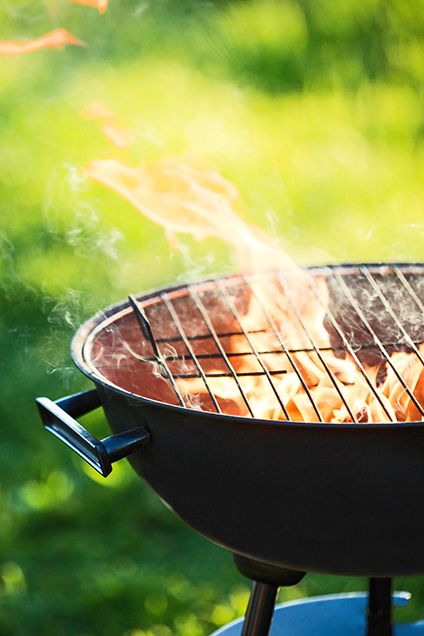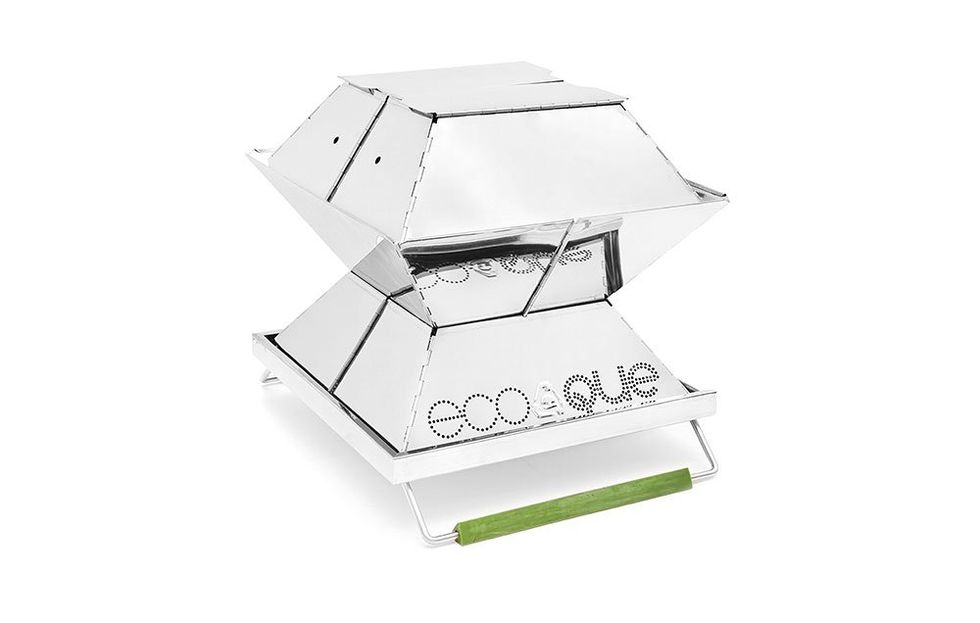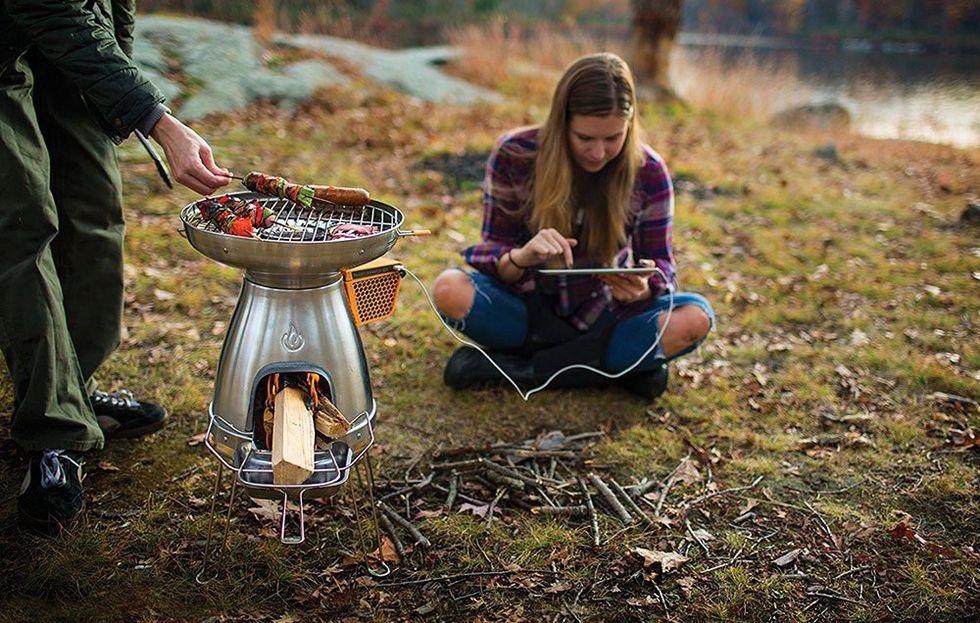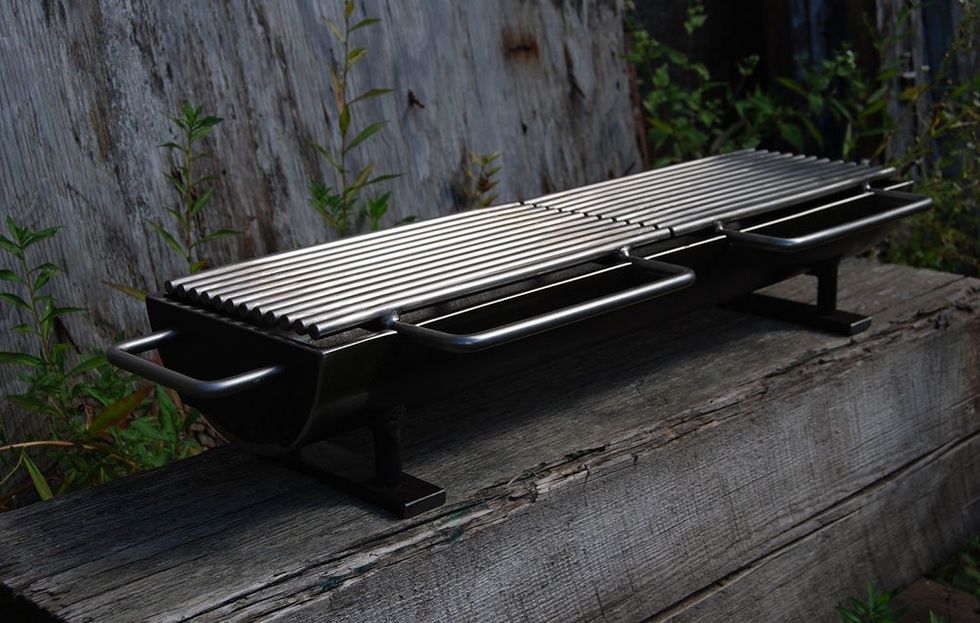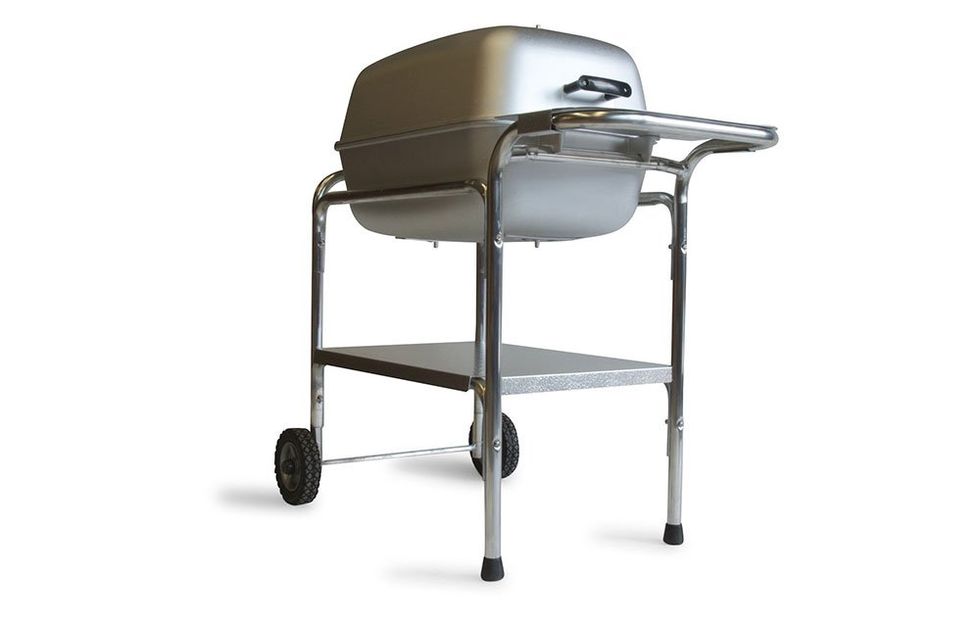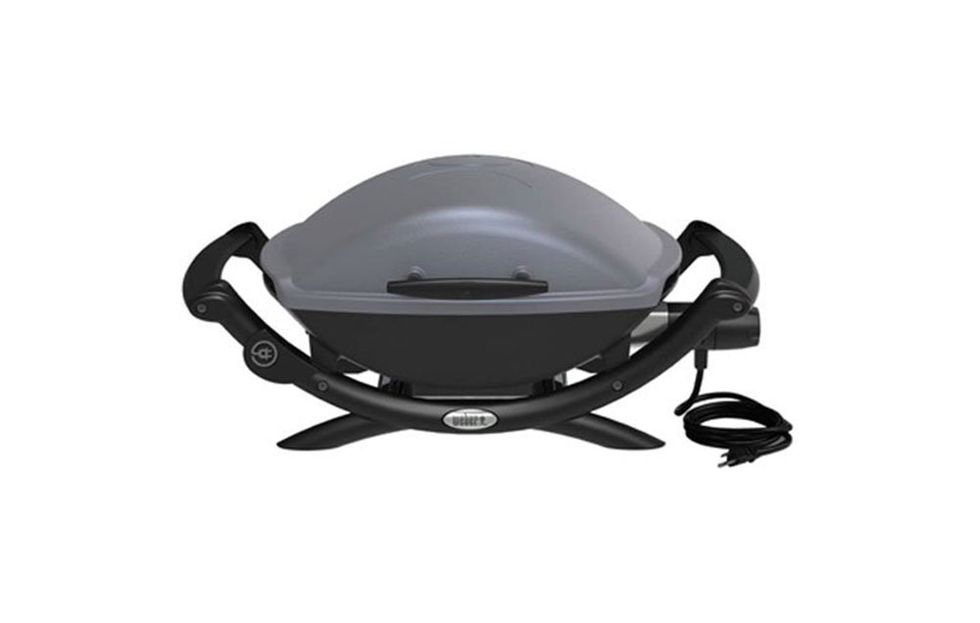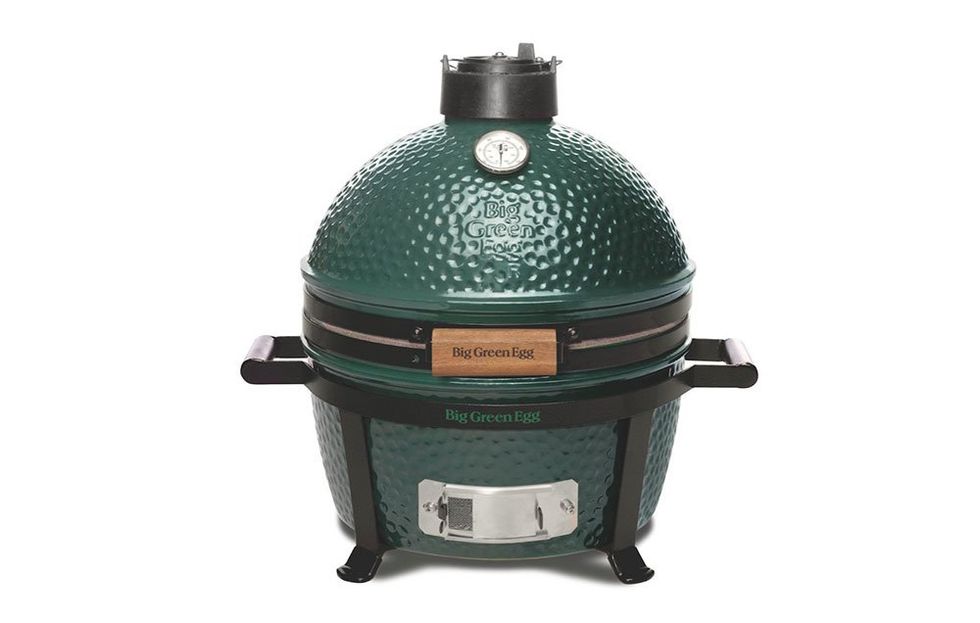Science can’t precisely date when humans first cooked with fire, but there’s an intriguing, scholarly theory that it was the critical event in our evolution, dating back more than a million years. Cooked food delivered more nutrients from plants and meat to the body than did raw food. Our bodies spent less energy gnawing on roots and leaves, more on important things, like enlarging our brains and discovering the joys of a wildebeest steak.
To cook, in that view, is to be fully human. To cook with fire: That taps into our earliest wiring as a social species. Cooking with fire is basic, and certainly natural, but that’s not the same thing as saying it comes naturally to the modern cook. For one thing, temperatures are approximate and uneven and tend to wax and wane based on fuel, wind, outdoor temperature, and a dozen other factors. I recently bought a 40-dollar laser gadget that gives instant temperature reads of coals, grate, grill dome, meat, or anything else I point it at. It revealed a wild range of temperatures in my Weber, from 1,200 degrees to 500 degrees: Grilling is the management of thermal chaos.
That’s why fire does not favor the inattentive cook. But isn’t that it’s charm? You must work with the fire, get to know its moods and locations, move the food around to get the benefits of direct and indirect heat, vary the distance between food and coals. Cooking with fire, once you get the hang of it, is the cooking that’s most like play, always a bit improvised.
Meanwhile, cooks have come to realize that fire is not just for cooking meat, but works its magic on fruits (here are the most grillable fruits), vegetables (here’s an insanely tasty miso dressing for any grilled veg), seafood and more—a welcome trend that makes for a more balanced meal from the grill. I recently cooked avocado, spring onions, mangoes, potatoes and wild-caught salmon on my grill—a whole, organic meal that went nicely with an Oregon Pinot Gris.
But then, ah, there’s the health question. The association of grill-charred meat with cancer risk is real but hard to quantify. Grilling produces two compounds, HCAs and PAHs, associated with cancer.
But because we crave the pleasures of fire, there are simple things the frequent griller can do to reduce the risks. Check out the list below to get wise ahead of time, so when it comes down to it, you can just cook. Read on for a guide to smarter, greener grilling. (And then check out these 9 healthy grilling recipes.)
Cooks, start your grills. A million years, more or less, after it first began, fire season is upon us.
Don't burn your food
Grilling meat produces two compounds associated with cancer: heterocyclic amines (HCAs) and polycyclic aromatic hydrocarbons (PAHs). High heat yields HCAs in animal proteins as they cook (that goes for meat browned or fried indoors, too). PAHs mostly occur when fat and juices drips onto coals and the fire bursts upward. To reduce the formation of those two cancer-causing compounds, trim excess fat before cooking, precook some foods (like ribs, which can be parboiled or par-baked) in nonfire heat. The shorter time meat spends over fire, the fewer compounds created. And don’t overchar your meats.
RELATED: Subscribe now and SAVE for Runner’s World magazine.
Grill plenty of plants
You’ll burn less fuel, waste less resources, and get the many health benefits of the phytochemicals and fiber in the vegetables and greens, which protect from cancer and are part of a healthy balanced diet. You can sear corn on the cob and larger leafy greens–even lettuces!–directly on the grill (see this recipe for charred leafy greens with shaved beets). To make grilled peas in the pod, grilled smashed potatoes, and other fall-through-the-holes vegetables (we’re looking at you, asparagus!) you’ll want to invest in a grill pan like Weber’s professional-grade grill pan ($22), made of heavy-grade recycleable stainless steel. Grill pans can also be used for meat, to avoid huge flare-ups by catching some of the drippings.
Marinate meats in beer or lemon
Research has shown that applying lemon or beer-based marinades inhibits the formation of cancer-causing PAH compounds in grilled meats. (Plus, they’re delicious!) Try this herb-and-lemon marinade for boneless pork ribs, or this dark beer marinade for pork loin. (Dark beer was shown to have a greater inhibitory effect on PAH compounds than pilsner.)
RW SHOP: Show your love of running with our new “Runner Runner Runner Runner” pint glass.
Choose cleaner charcoal
Which is greener, charcoal or gas? Both fuels used in gas grills—natural gas and its by-product, propane—are nonrenewable resources. But charcoal is black for a reason: It’s almost pure carbon. In 2009, a UK study estimated that charcoal had almost three times the carbon footprint of propane. Eric Johnson, who wrote the study, compares one charcoal grill session to driving a typical European car 26 miles. For propane, it’s equal to 9 miles. That carbon adds up. In 2003, the Oak Ridge National Laboratory calculated that on July 4 alone, Americans burned the equivalent of 2,300 acres of forest.
RELATED: 8 Healthy Uses for Activated Charcoal (and 3 You Can Skip)
What’s a charcoal lover to do? There are ways to reduce the footprint. Get the right gear; the more airtight and insulated your grill, the more efficient. Try to buy U.S.-made charcoal; our forests are increasing, unlike those in, say, Brazil. When you have glowing lump charcoal left over after cooking, close all vents to smother the fuel for use next time. And if you must use briquettes—ground charcoal pressed with binders—look for “all-natural,” and avoid the type infused with dirty petrochemical starters. Light your coals instead with a fast and efficient chimney starter. Below, the greenest charcoal on offer:
+ Coshell Briquets. No trees are harmed: These are made from coconut shells. They’re harder to light, but they burn very hot. $18 for 9 lb.
+ Royal Oak Ridge Briquets. Made from American scrapwood. $7 for 16 lb.
+ Whole Foods 365 Real Hardwood Charcoal. Lump charcoal “primarily” sourced from waste recovered from the lumber industry. About $7 for 8.8 lb.
Start coals, sans starter fluid
Weber’s highly rated, sturdy chimney starter is only $15, starts coals with no petrochemicals— all you need is your coals, a match, and two sheets of crumpled newspaper.
Grab grass-fed, organic beef
Why? Grass-fed means happier animals, less water pollution, fewer energy inputs, and healthier soil from proper, organic pasturing. Find it at markets like Whole Foods that label and rate meats, ask your butcher or local farmer, or join a meat CSA.
Related: Your Ultimate Guide to Grass-Fed Beef
Slice it thinner
The production of a single pound of beef requires a whopping 1,800 gallons of water. Clearly, we need to eat less of it. Try cooking moderate portions, such as in dishes like Korean short ribs, meant to be eaten along with equal-sized bites of starch and vegetables.
RELATED: Running’s Impact on the Earth
Take its temperature
Accurate temp checks are critical with grassfed meat, lest it dry out. iGrill2’s nifty thermometer has a smartphone app that tracks and buzzes you when temp is near your goal from 150 feet away. Get the 4-probe version ($140) to perfectly cook 4 steaks at once.
RW IN YOUR INBOX: Have the latest news, advice, and inspiration sent to you every day with our Runner’s World Newsletters.
Grill whole birds
Do the math: One 3-pound organic chicken is equal in weight to, say, six bone-in thighs. It takes three or four birds, then, to yield all of that thigh meat. So, which do you choose: Nothing but thigh from three to four different chickens, or one plump, intact bird offering a cut for every appetite? If you’re looking to waste less and eat better, the whole chicken is greater than the sum of its parts. (Check out these grill-roasted whole chickens with herbes de provence.)
RELATED: The Easiest Roast Chicken Recipe Ever
Grill shellfish
For a healthy, super-sustainable grilled protein, try grilled oysters with tarragon and miso butters. No plates necessary—these guys come in their own fire-ready serving vessels. Afterwards, bag the calcium-rich shells, crush them with a hammer, and place a tablespoonful in the bottom of each hole when planting bulbs. Grilled clams with chorizo and smoked paprika are not only delicious; they’re sustainable. Hand-harvested wild or farmed with basically zero inputs and little environmental impact, filter-feeding clams actually clean the water as they eat.
Select small fish
As much as you might like a thick, seared tuna steak, overfished ocean predators like bluefin are in trouble. Eat plentiful fish like rainbow trout, mackerel, or sea bass (here’s a recipe for sea bass with prosciutto, fennel, and grilled lemons) and use resources like Seafood Watch for help with sustainable selections. (Here are the 12 fish you should never eat.)
Get a grill grate
Grates are the hottest accessory right now; they sit on top of the grill to spread heat (reducing the amount of fuel you need to use), and reduce flare-up. These aircraft-aluminum grills should last forever and are fully recycleable. GrillGrates start at $22 for 12-inch models.
Wrap It Up
Soaked and wrapped around foods, Fire & Flavor’s sustainably sourced papers lend cedar-smoke flavor and help prevent burning.
Keep your grill gunk-free
To help control flare-ups, keep the grill clean of residue with Bambeco’s grill brush with bamboo handle and recycled stainless steel bristles ($19). Replaceable bristles mean this tool will last longer than most. (Here’s how to clean your grill the right way.)
Use a no-drip basting brush
Le Creuset’s basting brush ($15) has a long wood handle and fine silicone bristles (made from sand) that do a better job holding slick sauces than short bristles do, helping to keep the flavors on your food—and not in the fire, where drips cause harmful flare-ups.
Put it on a skewer
Grilling smaller pieces of food mean less time over the heat—and less opportunity for harmful compounds to form. Made from partially recycled steel, the flat-blade design of Bambeco’s four barbecue skewers ($15) is perfect for threading and flipping small cuts of meat. (And they’re recycleable!)
Handle the heat
Silicone is made from sand, it’s durable, and it insulates against heat better than cloth. These ekogrips BBQ gloves ($18) are good to 425 degrees, with lifetime warranty from Jolly Green Products.
Grill a pie or sandwich
Rome Industries Pie Sandwich Iron ($16) clamps pie dough or slices of bread—and whatever you put between them—tight. Hold or prop over campfire or grill for healthy sweet or savory treats. The wood handle is far from the heat to stay comfortable to hold even if you have a big fire.
Smoke sustainably
For that fire-kissed flavor without harmful char, the SmokeCage ($40) is a nifty steel device is made in Texas and uses nut shells left over from farming. Fill with pecan, walnut, pistachio or hazelnut shells, place on grill. Warranteed “up to, and including, the Zombie Apocalypse.”
Another sustainable option is Dr. Brownstones Signature Blend smoking chips, wich includes wild apple, black cherry and sugar maple from hand-harvested, sustainable Maine forests. $14.99 for a bag, approx. 2.5 pounds.
Upgrade your grill
If you're grilling on your trusty old Weber, by all means, continue—the techniques and grilling tools listed above will help you get the most out of the grill you already have. But if you’re in the market for a new grill, consider one of these energy-efficient models:
Use Lots Less Fuel. EcoQue ($99) claims its 15-inch square stainless grill uses 75 percent fewer briquettes than similar-sized portable grills. It folds flat to one inch thick.
Fire your Food, Power Your Phone. BioLite Base Camp ($200) portable stove uses excess energy from burning scrapwood or foraged wood to cook food on the grill while generating electricity to a USB port into which you can plug a device for charging. An internal fan also pumps air back to the fuel chamber for a more efficient burn, reducing emissions.
Grill on a Work of Art. Kotaigrill’s handmade recycleable steel hibachis ($700) come from a Maryland artisan who also makes incense burners.
Smoke or Grill It. Four vents—two on top and two on bottom—allow you to optimize the PK grill ($370) for direct or indirect cooking, meaning you can sizzle steaks one day, slow-smoke pork the next. Made of no-rust, 100% recycled aluminum and hand-assembled in the USA. Comes apart for toting to camp or tailgate party.
Choose Electric. Whether you’re in a no-coals-or-gas condo, have a renewable source of energy at your disposal, or simply like the idea of electric energy for your grilling, Weber’s Q 2400 ($299) has a respectable 280 square inches of grillspace and gets the cooking temperature to 500 degrees, yielding real grill flavor.
Egg-Style. Ceramic cookers are efficient because they retain heat for a long time, requiring less fuel, and are very air-tight, keeping all that good smoke in to flavor the food. The gold standard in the field is the Big Green Egg ($940).
The article 20 Tips For Healthy Green Grilling—Plus The Best Eco Friendly Grills To Buy originally appeared on Rodale’s Organic Life.
